University Business Idea Generation and Analysis Report
VerifiedAdded on 2021/05/30
|13
|2543
|37
Report
AI Summary
This report delves into the process of generating a business idea centered around a pen-structured water purifier. It begins by identifying customer needs and market problems, specifically focusing on the challenges faced by travelers in accessing clean and safe drinking water. The report then outlines the generation of the business idea, emphasizing the purifier's portability and ability to detect water impurities. Persuasive arguments are presented, highlighting the innovative aspects of the product, such as its integration of AI and the use of reusable components. The business model canvas, based on the Osterwalder & Pigneur framework, is employed to analyze the product's value proposition, infrastructure, and financial aspects. The report also examines the critical success factors for the business idea and assesses its feasibility, considering market dynamics and the potential for disruptive innovation. Ultimately, the report concludes that the successful identification of customer needs is crucial for driving innovation in the product and ensuring its sustainability in the international market.
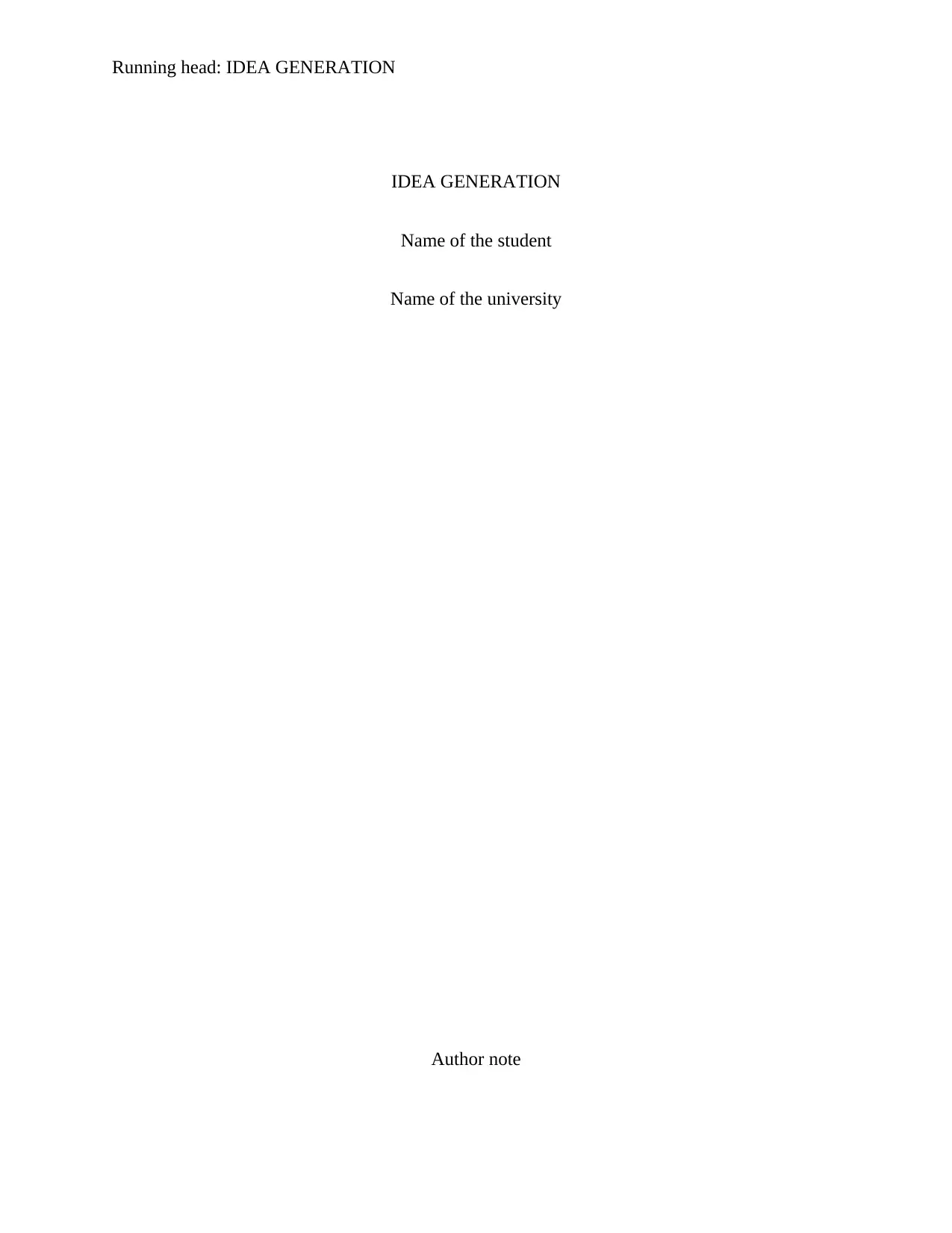
Running head: IDEA GENERATION
IDEA GENERATION
Name of the student
Name of the university
Author note
IDEA GENERATION
Name of the student
Name of the university
Author note
Paraphrase This Document
Need a fresh take? Get an instant paraphrase of this document with our AI Paraphraser
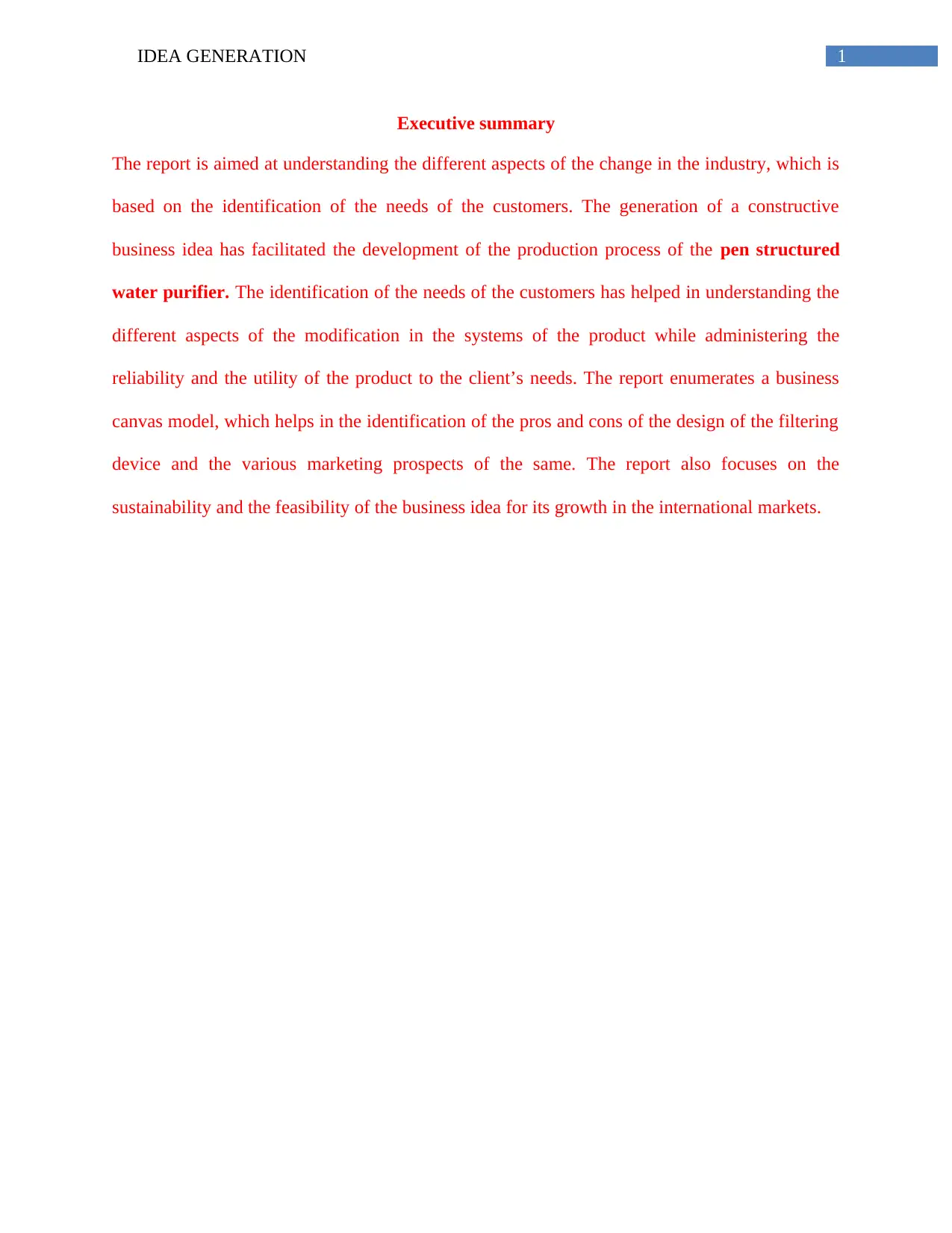
1IDEA GENERATION
Executive summary
The report is aimed at understanding the different aspects of the change in the industry, which is
based on the identification of the needs of the customers. The generation of a constructive
business idea has facilitated the development of the production process of the pen structured
water purifier. The identification of the needs of the customers has helped in understanding the
different aspects of the modification in the systems of the product while administering the
reliability and the utility of the product to the client’s needs. The report enumerates a business
canvas model, which helps in the identification of the pros and cons of the design of the filtering
device and the various marketing prospects of the same. The report also focuses on the
sustainability and the feasibility of the business idea for its growth in the international markets.
Executive summary
The report is aimed at understanding the different aspects of the change in the industry, which is
based on the identification of the needs of the customers. The generation of a constructive
business idea has facilitated the development of the production process of the pen structured
water purifier. The identification of the needs of the customers has helped in understanding the
different aspects of the modification in the systems of the product while administering the
reliability and the utility of the product to the client’s needs. The report enumerates a business
canvas model, which helps in the identification of the pros and cons of the design of the filtering
device and the various marketing prospects of the same. The report also focuses on the
sustainability and the feasibility of the business idea for its growth in the international markets.
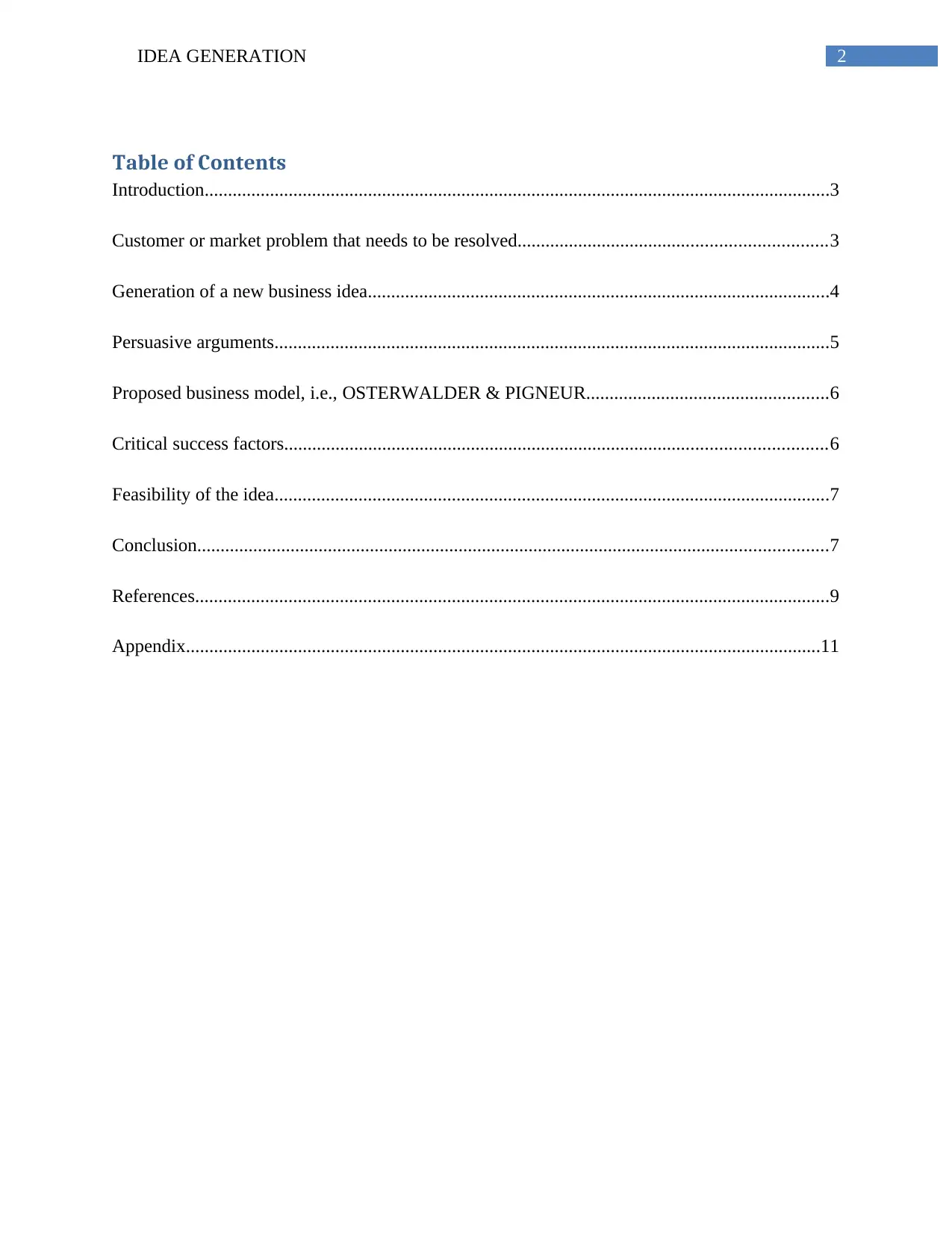
2IDEA GENERATION
Table of Contents
Introduction......................................................................................................................................3
Customer or market problem that needs to be resolved..................................................................3
Generation of a new business idea...................................................................................................4
Persuasive arguments.......................................................................................................................5
Proposed business model, i.e., OSTERWALDER & PIGNEUR....................................................6
Critical success factors....................................................................................................................6
Feasibility of the idea.......................................................................................................................7
Conclusion.......................................................................................................................................7
References........................................................................................................................................9
Appendix........................................................................................................................................11
Table of Contents
Introduction......................................................................................................................................3
Customer or market problem that needs to be resolved..................................................................3
Generation of a new business idea...................................................................................................4
Persuasive arguments.......................................................................................................................5
Proposed business model, i.e., OSTERWALDER & PIGNEUR....................................................6
Critical success factors....................................................................................................................6
Feasibility of the idea.......................................................................................................................7
Conclusion.......................................................................................................................................7
References........................................................................................................................................9
Appendix........................................................................................................................................11
⊘ This is a preview!⊘
Do you want full access?
Subscribe today to unlock all pages.

Trusted by 1+ million students worldwide
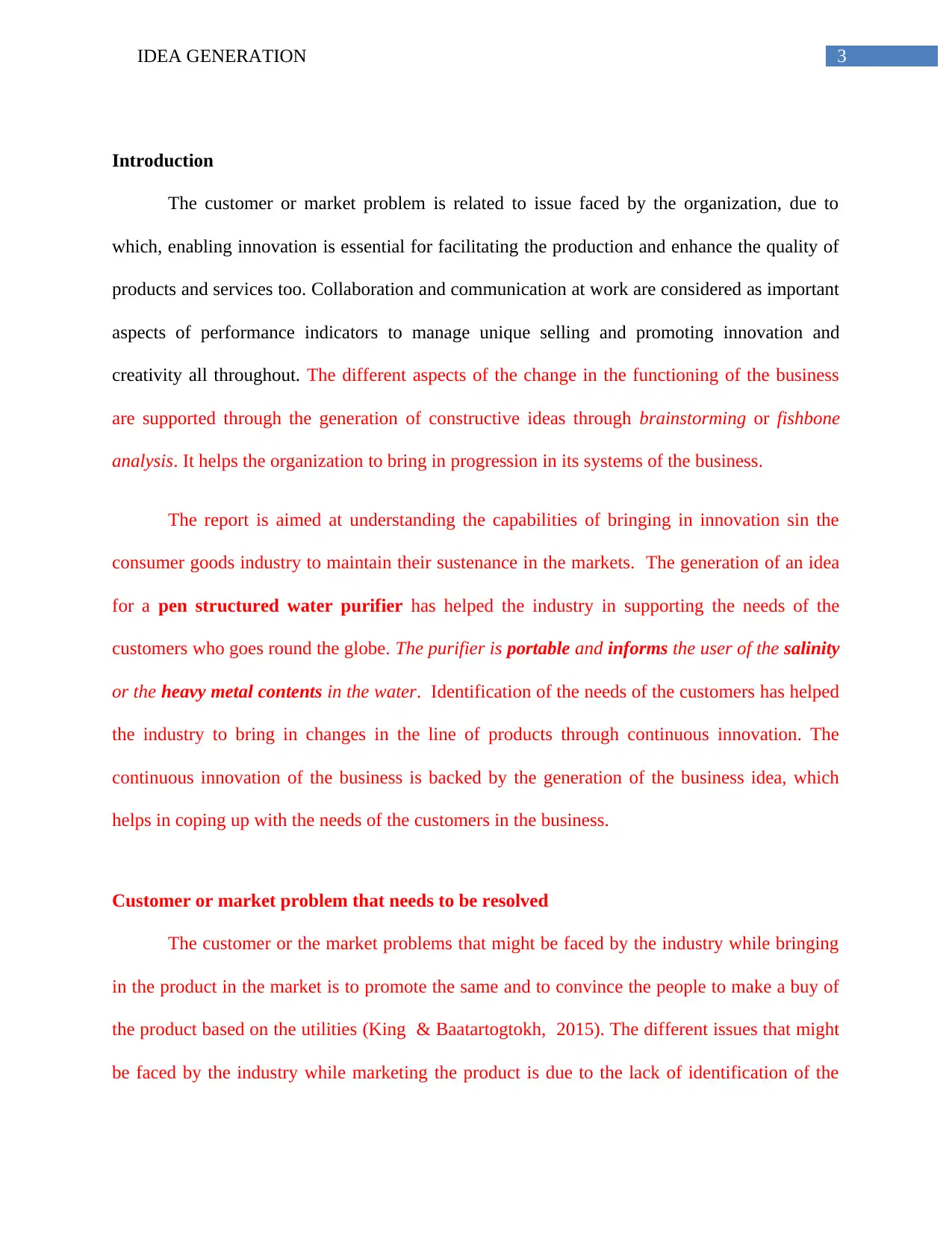
3IDEA GENERATION
Introduction
The customer or market problem is related to issue faced by the organization, due to
which, enabling innovation is essential for facilitating the production and enhance the quality of
products and services too. Collaboration and communication at work are considered as important
aspects of performance indicators to manage unique selling and promoting innovation and
creativity all throughout. The different aspects of the change in the functioning of the business
are supported through the generation of constructive ideas through brainstorming or fishbone
analysis. It helps the organization to bring in progression in its systems of the business.
The report is aimed at understanding the capabilities of bringing in innovation sin the
consumer goods industry to maintain their sustenance in the markets. The generation of an idea
for a pen structured water purifier has helped the industry in supporting the needs of the
customers who goes round the globe. The purifier is portable and informs the user of the salinity
or the heavy metal contents in the water. Identification of the needs of the customers has helped
the industry to bring in changes in the line of products through continuous innovation. The
continuous innovation of the business is backed by the generation of the business idea, which
helps in coping up with the needs of the customers in the business.
Customer or market problem that needs to be resolved
The customer or the market problems that might be faced by the industry while bringing
in the product in the market is to promote the same and to convince the people to make a buy of
the product based on the utilities (King & Baatartogtokh, 2015). The different issues that might
be faced by the industry while marketing the product is due to the lack of identification of the
Introduction
The customer or market problem is related to issue faced by the organization, due to
which, enabling innovation is essential for facilitating the production and enhance the quality of
products and services too. Collaboration and communication at work are considered as important
aspects of performance indicators to manage unique selling and promoting innovation and
creativity all throughout. The different aspects of the change in the functioning of the business
are supported through the generation of constructive ideas through brainstorming or fishbone
analysis. It helps the organization to bring in progression in its systems of the business.
The report is aimed at understanding the capabilities of bringing in innovation sin the
consumer goods industry to maintain their sustenance in the markets. The generation of an idea
for a pen structured water purifier has helped the industry in supporting the needs of the
customers who goes round the globe. The purifier is portable and informs the user of the salinity
or the heavy metal contents in the water. Identification of the needs of the customers has helped
the industry to bring in changes in the line of products through continuous innovation. The
continuous innovation of the business is backed by the generation of the business idea, which
helps in coping up with the needs of the customers in the business.
Customer or market problem that needs to be resolved
The customer or the market problems that might be faced by the industry while bringing
in the product in the market is to promote the same and to convince the people to make a buy of
the product based on the utilities (King & Baatartogtokh, 2015). The different issues that might
be faced by the industry while marketing the product is due to the lack of identification of the
Paraphrase This Document
Need a fresh take? Get an instant paraphrase of this document with our AI Paraphraser
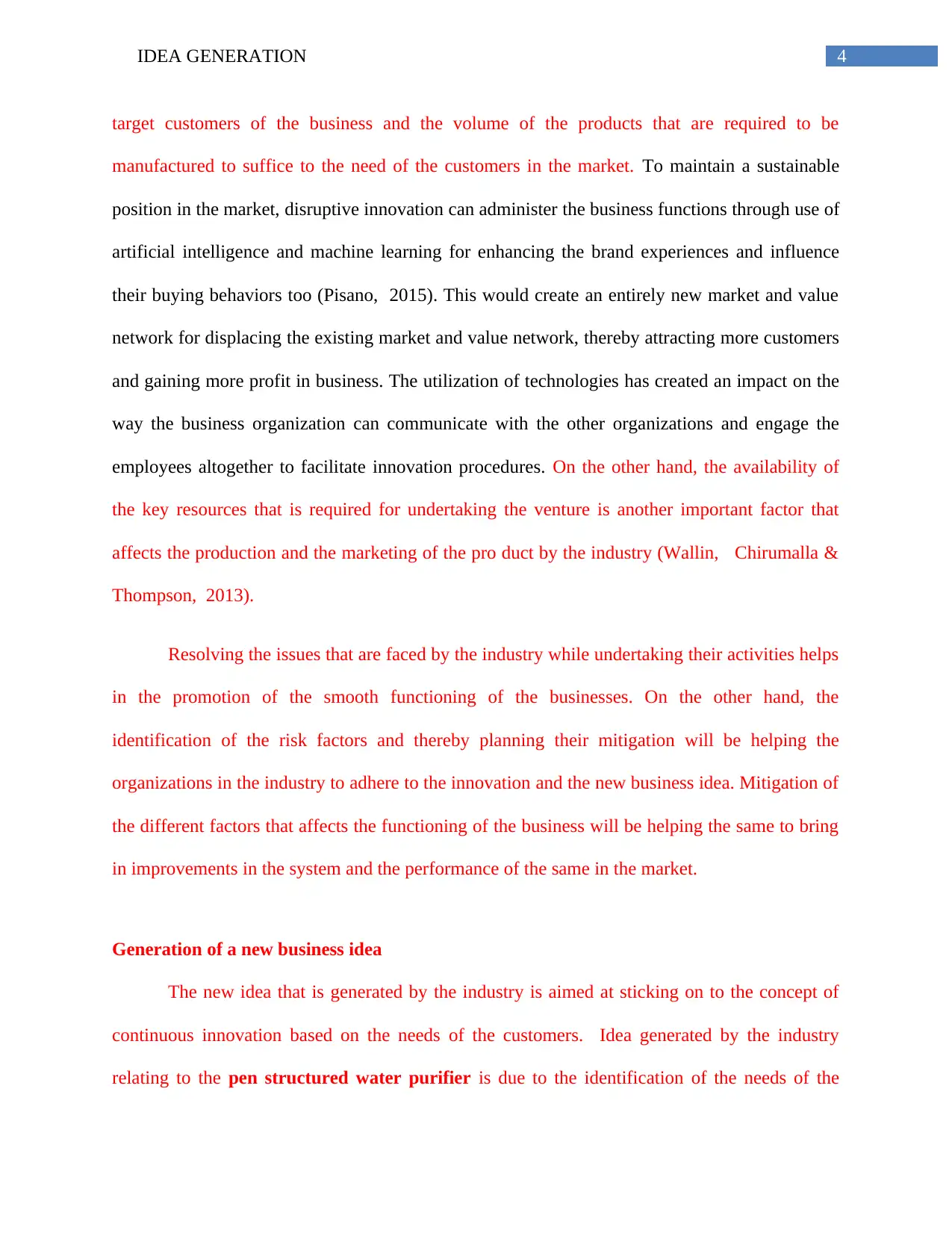
4IDEA GENERATION
target customers of the business and the volume of the products that are required to be
manufactured to suffice to the need of the customers in the market. To maintain a sustainable
position in the market, disruptive innovation can administer the business functions through use of
artificial intelligence and machine learning for enhancing the brand experiences and influence
their buying behaviors too (Pisano, 2015). This would create an entirely new market and value
network for displacing the existing market and value network, thereby attracting more customers
and gaining more profit in business. The utilization of technologies has created an impact on the
way the business organization can communicate with the other organizations and engage the
employees altogether to facilitate innovation procedures. On the other hand, the availability of
the key resources that is required for undertaking the venture is another important factor that
affects the production and the marketing of the pro duct by the industry (Wallin, Chirumalla &
Thompson, 2013).
Resolving the issues that are faced by the industry while undertaking their activities helps
in the promotion of the smooth functioning of the businesses. On the other hand, the
identification of the risk factors and thereby planning their mitigation will be helping the
organizations in the industry to adhere to the innovation and the new business idea. Mitigation of
the different factors that affects the functioning of the business will be helping the same to bring
in improvements in the system and the performance of the same in the market.
Generation of a new business idea
The new idea that is generated by the industry is aimed at sticking on to the concept of
continuous innovation based on the needs of the customers. Idea generated by the industry
relating to the pen structured water purifier is due to the identification of the needs of the
target customers of the business and the volume of the products that are required to be
manufactured to suffice to the need of the customers in the market. To maintain a sustainable
position in the market, disruptive innovation can administer the business functions through use of
artificial intelligence and machine learning for enhancing the brand experiences and influence
their buying behaviors too (Pisano, 2015). This would create an entirely new market and value
network for displacing the existing market and value network, thereby attracting more customers
and gaining more profit in business. The utilization of technologies has created an impact on the
way the business organization can communicate with the other organizations and engage the
employees altogether to facilitate innovation procedures. On the other hand, the availability of
the key resources that is required for undertaking the venture is another important factor that
affects the production and the marketing of the pro duct by the industry (Wallin, Chirumalla &
Thompson, 2013).
Resolving the issues that are faced by the industry while undertaking their activities helps
in the promotion of the smooth functioning of the businesses. On the other hand, the
identification of the risk factors and thereby planning their mitigation will be helping the
organizations in the industry to adhere to the innovation and the new business idea. Mitigation of
the different factors that affects the functioning of the business will be helping the same to bring
in improvements in the system and the performance of the same in the market.
Generation of a new business idea
The new idea that is generated by the industry is aimed at sticking on to the concept of
continuous innovation based on the needs of the customers. Idea generated by the industry
relating to the pen structured water purifier is due to the identification of the needs of the
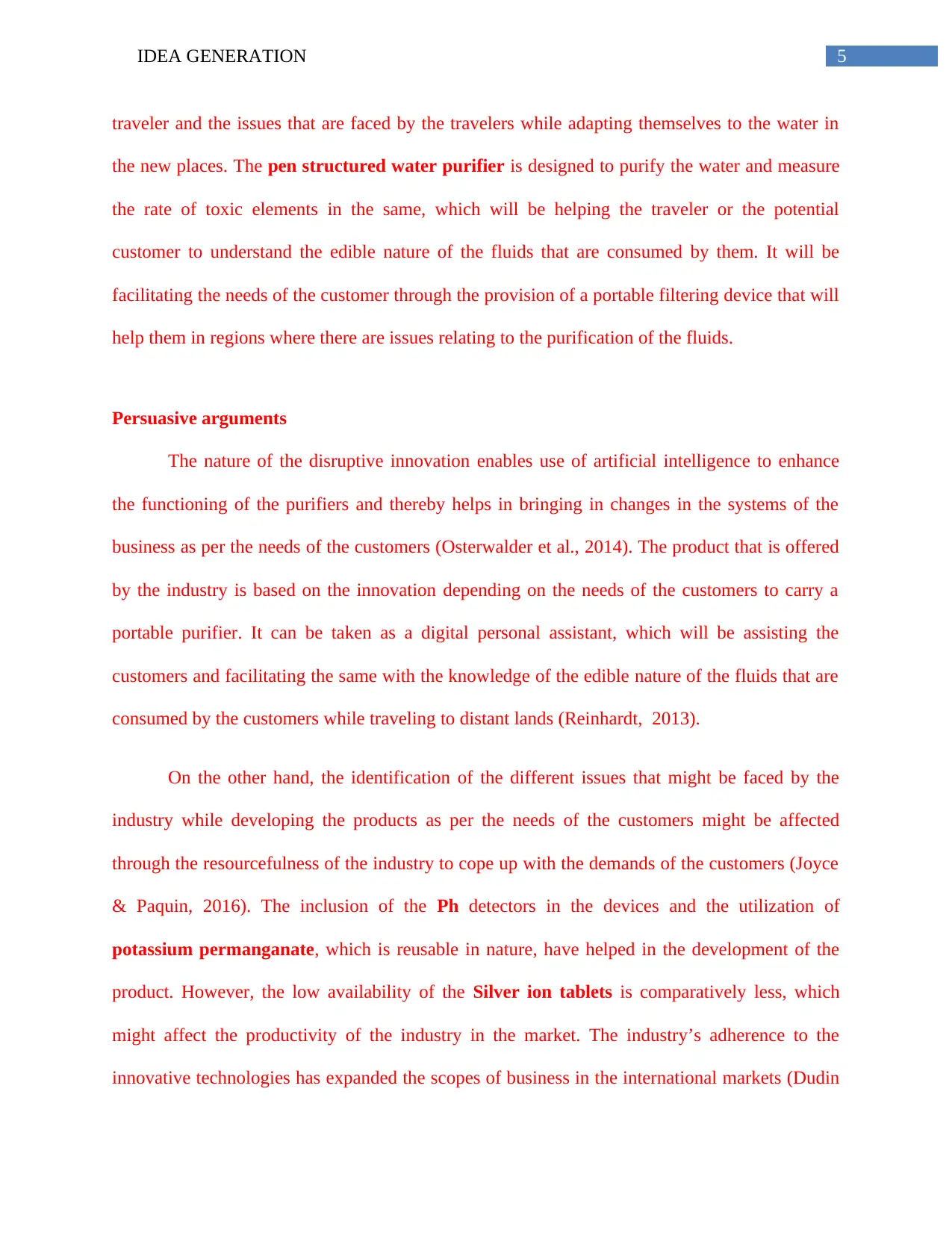
5IDEA GENERATION
traveler and the issues that are faced by the travelers while adapting themselves to the water in
the new places. The pen structured water purifier is designed to purify the water and measure
the rate of toxic elements in the same, which will be helping the traveler or the potential
customer to understand the edible nature of the fluids that are consumed by them. It will be
facilitating the needs of the customer through the provision of a portable filtering device that will
help them in regions where there are issues relating to the purification of the fluids.
Persuasive arguments
The nature of the disruptive innovation enables use of artificial intelligence to enhance
the functioning of the purifiers and thereby helps in bringing in changes in the systems of the
business as per the needs of the customers (Osterwalder et al., 2014). The product that is offered
by the industry is based on the innovation depending on the needs of the customers to carry a
portable purifier. It can be taken as a digital personal assistant, which will be assisting the
customers and facilitating the same with the knowledge of the edible nature of the fluids that are
consumed by the customers while traveling to distant lands (Reinhardt, 2013).
On the other hand, the identification of the different issues that might be faced by the
industry while developing the products as per the needs of the customers might be affected
through the resourcefulness of the industry to cope up with the demands of the customers (Joyce
& Paquin, 2016). The inclusion of the Ph detectors in the devices and the utilization of
potassium permanganate, which is reusable in nature, have helped in the development of the
product. However, the low availability of the Silver ion tablets is comparatively less, which
might affect the productivity of the industry in the market. The industry’s adherence to the
innovative technologies has expanded the scopes of business in the international markets (Dudin
traveler and the issues that are faced by the travelers while adapting themselves to the water in
the new places. The pen structured water purifier is designed to purify the water and measure
the rate of toxic elements in the same, which will be helping the traveler or the potential
customer to understand the edible nature of the fluids that are consumed by them. It will be
facilitating the needs of the customer through the provision of a portable filtering device that will
help them in regions where there are issues relating to the purification of the fluids.
Persuasive arguments
The nature of the disruptive innovation enables use of artificial intelligence to enhance
the functioning of the purifiers and thereby helps in bringing in changes in the systems of the
business as per the needs of the customers (Osterwalder et al., 2014). The product that is offered
by the industry is based on the innovation depending on the needs of the customers to carry a
portable purifier. It can be taken as a digital personal assistant, which will be assisting the
customers and facilitating the same with the knowledge of the edible nature of the fluids that are
consumed by the customers while traveling to distant lands (Reinhardt, 2013).
On the other hand, the identification of the different issues that might be faced by the
industry while developing the products as per the needs of the customers might be affected
through the resourcefulness of the industry to cope up with the demands of the customers (Joyce
& Paquin, 2016). The inclusion of the Ph detectors in the devices and the utilization of
potassium permanganate, which is reusable in nature, have helped in the development of the
product. However, the low availability of the Silver ion tablets is comparatively less, which
might affect the productivity of the industry in the market. The industry’s adherence to the
innovative technologies has expanded the scopes of business in the international markets (Dudin
⊘ This is a preview!⊘
Do you want full access?
Subscribe today to unlock all pages.

Trusted by 1+ million students worldwide
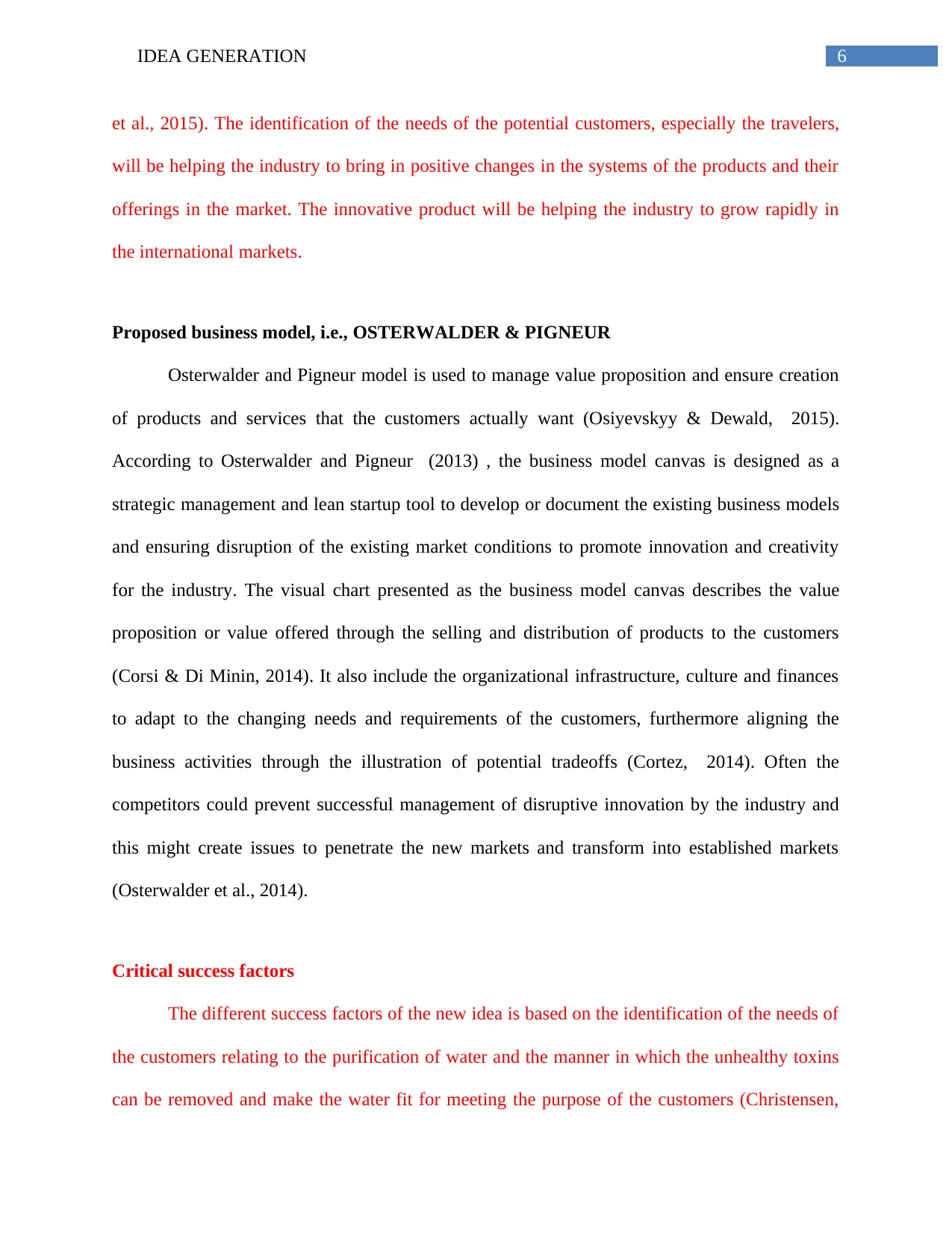
6IDEA GENERATION
et al., 2015). The identification of the needs of the potential customers, especially the travelers,
will be helping the industry to bring in positive changes in the systems of the products and their
offerings in the market. The innovative product will be helping the industry to grow rapidly in
the international markets.
Proposed business model, i.e., OSTERWALDER & PIGNEUR
Osterwalder and Pigneur model is used to manage value proposition and ensure creation
of products and services that the customers actually want (Osiyevskyy & Dewald, 2015).
According to Osterwalder and Pigneur (2013) , the business model canvas is designed as a
strategic management and lean startup tool to develop or document the existing business models
and ensuring disruption of the existing market conditions to promote innovation and creativity
for the industry. The visual chart presented as the business model canvas describes the value
proposition or value offered through the selling and distribution of products to the customers
(Corsi & Di Minin, 2014). It also include the organizational infrastructure, culture and finances
to adapt to the changing needs and requirements of the customers, furthermore aligning the
business activities through the illustration of potential tradeoffs (Cortez, 2014). Often the
competitors could prevent successful management of disruptive innovation by the industry and
this might create issues to penetrate the new markets and transform into established markets
(Osterwalder et al., 2014).
Critical success factors
The different success factors of the new idea is based on the identification of the needs of
the customers relating to the purification of water and the manner in which the unhealthy toxins
can be removed and make the water fit for meeting the purpose of the customers (Christensen,
et al., 2015). The identification of the needs of the potential customers, especially the travelers,
will be helping the industry to bring in positive changes in the systems of the products and their
offerings in the market. The innovative product will be helping the industry to grow rapidly in
the international markets.
Proposed business model, i.e., OSTERWALDER & PIGNEUR
Osterwalder and Pigneur model is used to manage value proposition and ensure creation
of products and services that the customers actually want (Osiyevskyy & Dewald, 2015).
According to Osterwalder and Pigneur (2013) , the business model canvas is designed as a
strategic management and lean startup tool to develop or document the existing business models
and ensuring disruption of the existing market conditions to promote innovation and creativity
for the industry. The visual chart presented as the business model canvas describes the value
proposition or value offered through the selling and distribution of products to the customers
(Corsi & Di Minin, 2014). It also include the organizational infrastructure, culture and finances
to adapt to the changing needs and requirements of the customers, furthermore aligning the
business activities through the illustration of potential tradeoffs (Cortez, 2014). Often the
competitors could prevent successful management of disruptive innovation by the industry and
this might create issues to penetrate the new markets and transform into established markets
(Osterwalder et al., 2014).
Critical success factors
The different success factors of the new idea is based on the identification of the needs of
the customers relating to the purification of water and the manner in which the unhealthy toxins
can be removed and make the water fit for meeting the purpose of the customers (Christensen,
Paraphrase This Document
Need a fresh take? Get an instant paraphrase of this document with our AI Paraphraser
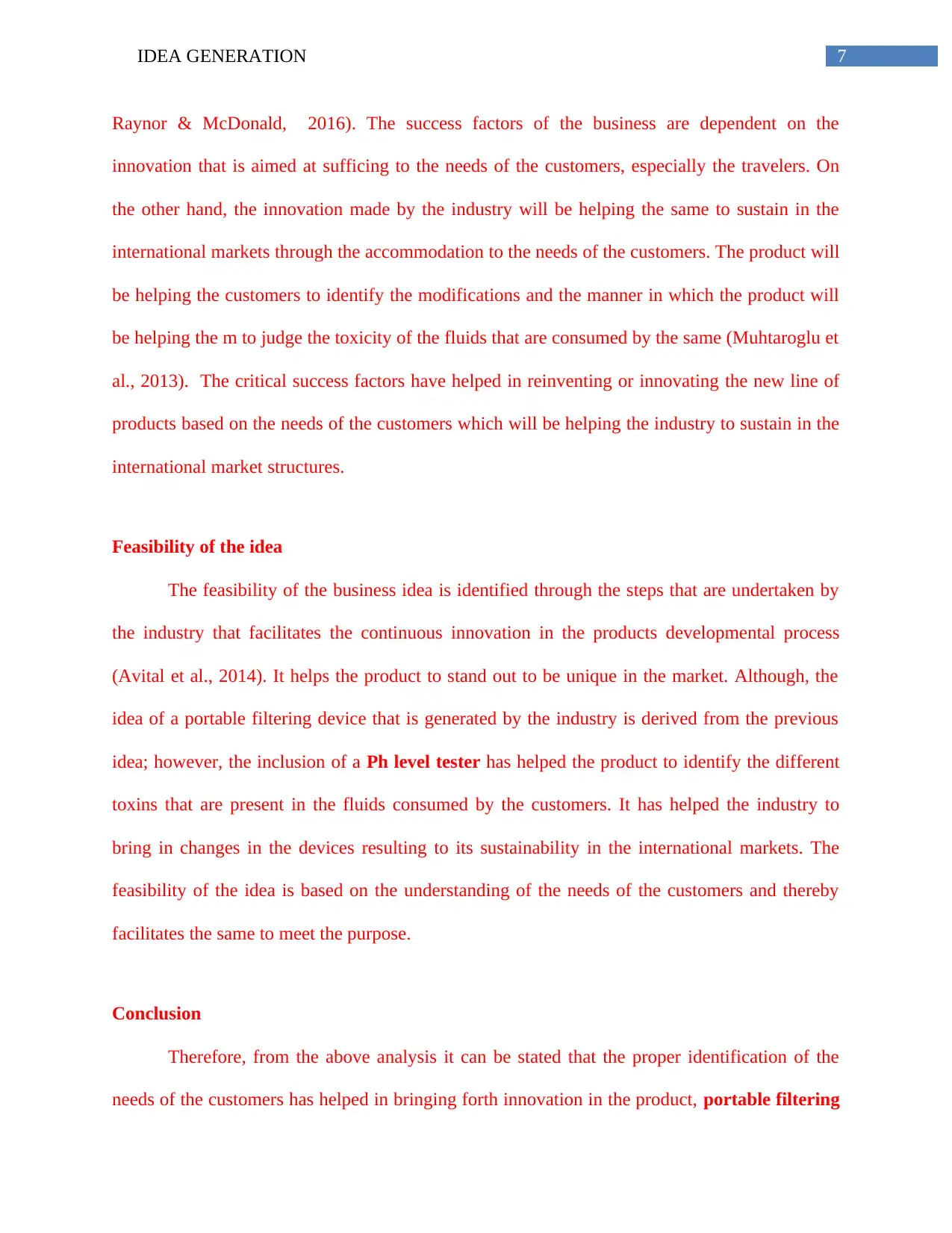
7IDEA GENERATION
Raynor & McDonald, 2016). The success factors of the business are dependent on the
innovation that is aimed at sufficing to the needs of the customers, especially the travelers. On
the other hand, the innovation made by the industry will be helping the same to sustain in the
international markets through the accommodation to the needs of the customers. The product will
be helping the customers to identify the modifications and the manner in which the product will
be helping the m to judge the toxicity of the fluids that are consumed by the same (Muhtaroglu et
al., 2013). The critical success factors have helped in reinventing or innovating the new line of
products based on the needs of the customers which will be helping the industry to sustain in the
international market structures.
Feasibility of the idea
The feasibility of the business idea is identified through the steps that are undertaken by
the industry that facilitates the continuous innovation in the products developmental process
(Avital et al., 2014). It helps the product to stand out to be unique in the market. Although, the
idea of a portable filtering device that is generated by the industry is derived from the previous
idea; however, the inclusion of a Ph level tester has helped the product to identify the different
toxins that are present in the fluids consumed by the customers. It has helped the industry to
bring in changes in the devices resulting to its sustainability in the international markets. The
feasibility of the idea is based on the understanding of the needs of the customers and thereby
facilitates the same to meet the purpose.
Conclusion
Therefore, from the above analysis it can be stated that the proper identification of the
needs of the customers has helped in bringing forth innovation in the product, portable filtering
Raynor & McDonald, 2016). The success factors of the business are dependent on the
innovation that is aimed at sufficing to the needs of the customers, especially the travelers. On
the other hand, the innovation made by the industry will be helping the same to sustain in the
international markets through the accommodation to the needs of the customers. The product will
be helping the customers to identify the modifications and the manner in which the product will
be helping the m to judge the toxicity of the fluids that are consumed by the same (Muhtaroglu et
al., 2013). The critical success factors have helped in reinventing or innovating the new line of
products based on the needs of the customers which will be helping the industry to sustain in the
international market structures.
Feasibility of the idea
The feasibility of the business idea is identified through the steps that are undertaken by
the industry that facilitates the continuous innovation in the products developmental process
(Avital et al., 2014). It helps the product to stand out to be unique in the market. Although, the
idea of a portable filtering device that is generated by the industry is derived from the previous
idea; however, the inclusion of a Ph level tester has helped the product to identify the different
toxins that are present in the fluids consumed by the customers. It has helped the industry to
bring in changes in the devices resulting to its sustainability in the international markets. The
feasibility of the idea is based on the understanding of the needs of the customers and thereby
facilitates the same to meet the purpose.
Conclusion
Therefore, from the above analysis it can be stated that the proper identification of the
needs of the customers has helped in bringing forth innovation in the product, portable filtering
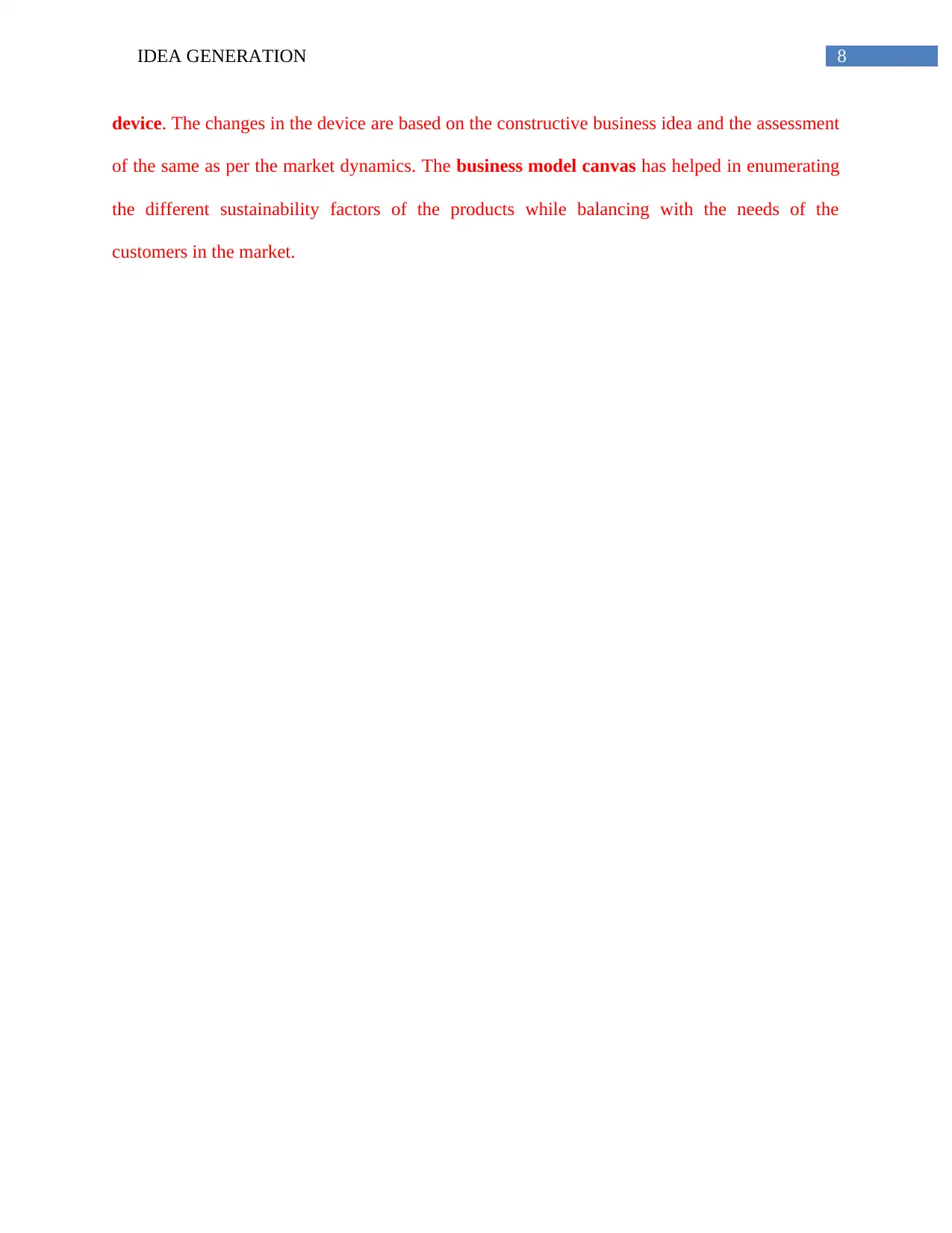
8IDEA GENERATION
device. The changes in the device are based on the constructive business idea and the assessment
of the same as per the market dynamics. The business model canvas has helped in enumerating
the different sustainability factors of the products while balancing with the needs of the
customers in the market.
device. The changes in the device are based on the constructive business idea and the assessment
of the same as per the market dynamics. The business model canvas has helped in enumerating
the different sustainability factors of the products while balancing with the needs of the
customers in the market.
⊘ This is a preview!⊘
Do you want full access?
Subscribe today to unlock all pages.

Trusted by 1+ million students worldwide
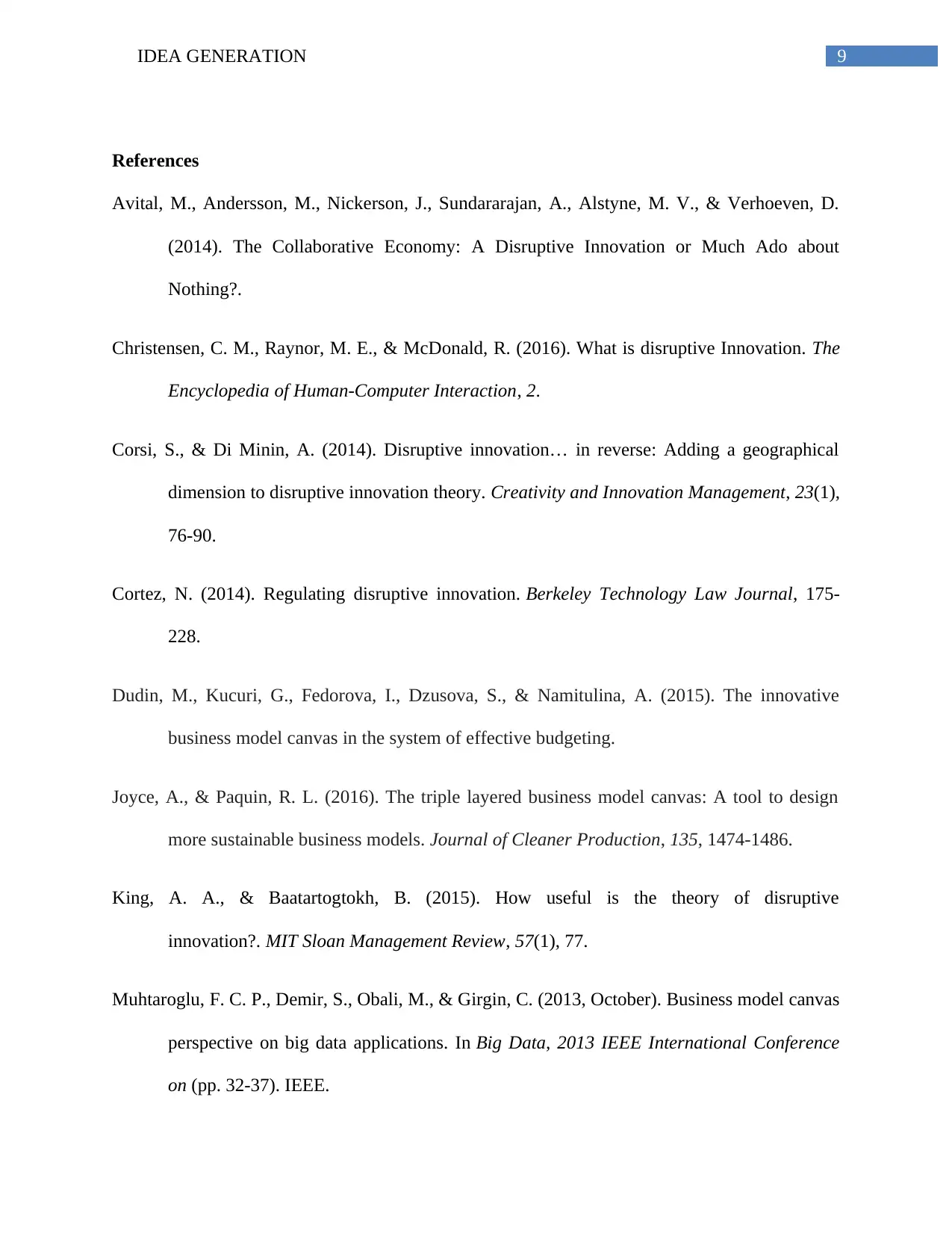
9IDEA GENERATION
References
Avital, M., Andersson, M., Nickerson, J., Sundararajan, A., Alstyne, M. V., & Verhoeven, D.
(2014). The Collaborative Economy: A Disruptive Innovation or Much Ado about
Nothing?.
Christensen, C. M., Raynor, M. E., & McDonald, R. (2016). What is disruptive Innovation. The
Encyclopedia of Human-Computer Interaction, 2.
Corsi, S., & Di Minin, A. (2014). Disruptive innovation… in reverse: Adding a geographical
dimension to disruptive innovation theory. Creativity and Innovation Management, 23(1),
76-90.
Cortez, N. (2014). Regulating disruptive innovation. Berkeley Technology Law Journal, 175-
228.
Dudin, M., Kucuri, G., Fedorova, I., Dzusova, S., & Namitulina, A. (2015). The innovative
business model canvas in the system of effective budgeting.
Joyce, A., & Paquin, R. L. (2016). The triple layered business model canvas: A tool to design
more sustainable business models. Journal of Cleaner Production, 135, 1474-1486.
King, A. A., & Baatartogtokh, B. (2015). How useful is the theory of disruptive
innovation?. MIT Sloan Management Review, 57(1), 77.
Muhtaroglu, F. C. P., Demir, S., Obali, M., & Girgin, C. (2013, October). Business model canvas
perspective on big data applications. In Big Data, 2013 IEEE International Conference
on (pp. 32-37). IEEE.
References
Avital, M., Andersson, M., Nickerson, J., Sundararajan, A., Alstyne, M. V., & Verhoeven, D.
(2014). The Collaborative Economy: A Disruptive Innovation or Much Ado about
Nothing?.
Christensen, C. M., Raynor, M. E., & McDonald, R. (2016). What is disruptive Innovation. The
Encyclopedia of Human-Computer Interaction, 2.
Corsi, S., & Di Minin, A. (2014). Disruptive innovation… in reverse: Adding a geographical
dimension to disruptive innovation theory. Creativity and Innovation Management, 23(1),
76-90.
Cortez, N. (2014). Regulating disruptive innovation. Berkeley Technology Law Journal, 175-
228.
Dudin, M., Kucuri, G., Fedorova, I., Dzusova, S., & Namitulina, A. (2015). The innovative
business model canvas in the system of effective budgeting.
Joyce, A., & Paquin, R. L. (2016). The triple layered business model canvas: A tool to design
more sustainable business models. Journal of Cleaner Production, 135, 1474-1486.
King, A. A., & Baatartogtokh, B. (2015). How useful is the theory of disruptive
innovation?. MIT Sloan Management Review, 57(1), 77.
Muhtaroglu, F. C. P., Demir, S., Obali, M., & Girgin, C. (2013, October). Business model canvas
perspective on big data applications. In Big Data, 2013 IEEE International Conference
on (pp. 32-37). IEEE.
Paraphrase This Document
Need a fresh take? Get an instant paraphrase of this document with our AI Paraphraser
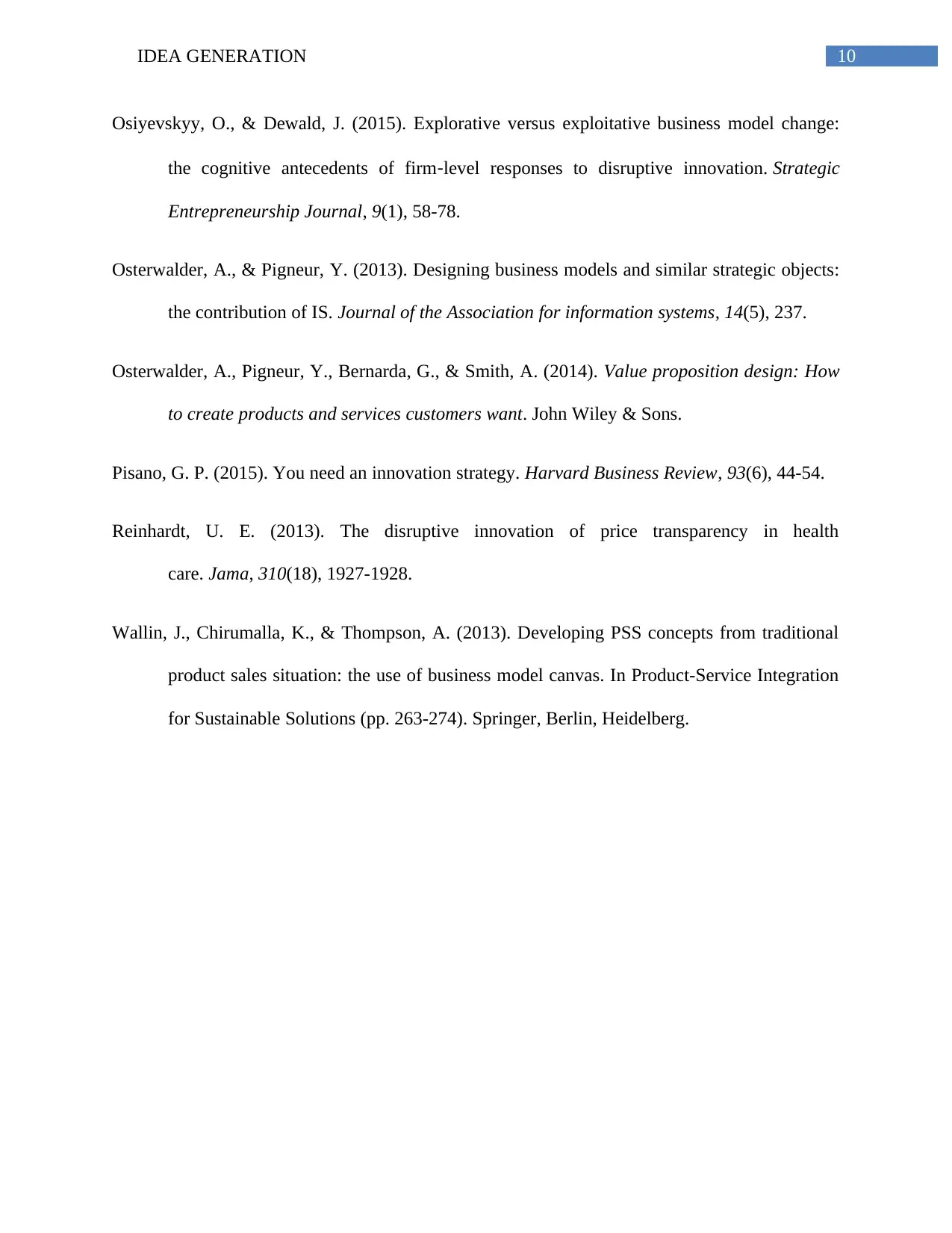
10IDEA GENERATION
Osiyevskyy, O., & Dewald, J. (2015). Explorative versus exploitative business model change:
the cognitive antecedents of firm‐level responses to disruptive innovation. Strategic
Entrepreneurship Journal, 9(1), 58-78.
Osterwalder, A., & Pigneur, Y. (2013). Designing business models and similar strategic objects:
the contribution of IS. Journal of the Association for information systems, 14(5), 237.
Osterwalder, A., Pigneur, Y., Bernarda, G., & Smith, A. (2014). Value proposition design: How
to create products and services customers want. John Wiley & Sons.
Pisano, G. P. (2015). You need an innovation strategy. Harvard Business Review, 93(6), 44-54.
Reinhardt, U. E. (2013). The disruptive innovation of price transparency in health
care. Jama, 310(18), 1927-1928.
Wallin, J., Chirumalla, K., & Thompson, A. (2013). Developing PSS concepts from traditional
product sales situation: the use of business model canvas. In Product-Service Integration
for Sustainable Solutions (pp. 263-274). Springer, Berlin, Heidelberg.
Osiyevskyy, O., & Dewald, J. (2015). Explorative versus exploitative business model change:
the cognitive antecedents of firm‐level responses to disruptive innovation. Strategic
Entrepreneurship Journal, 9(1), 58-78.
Osterwalder, A., & Pigneur, Y. (2013). Designing business models and similar strategic objects:
the contribution of IS. Journal of the Association for information systems, 14(5), 237.
Osterwalder, A., Pigneur, Y., Bernarda, G., & Smith, A. (2014). Value proposition design: How
to create products and services customers want. John Wiley & Sons.
Pisano, G. P. (2015). You need an innovation strategy. Harvard Business Review, 93(6), 44-54.
Reinhardt, U. E. (2013). The disruptive innovation of price transparency in health
care. Jama, 310(18), 1927-1928.
Wallin, J., Chirumalla, K., & Thompson, A. (2013). Developing PSS concepts from traditional
product sales situation: the use of business model canvas. In Product-Service Integration
for Sustainable Solutions (pp. 263-274). Springer, Berlin, Heidelberg.
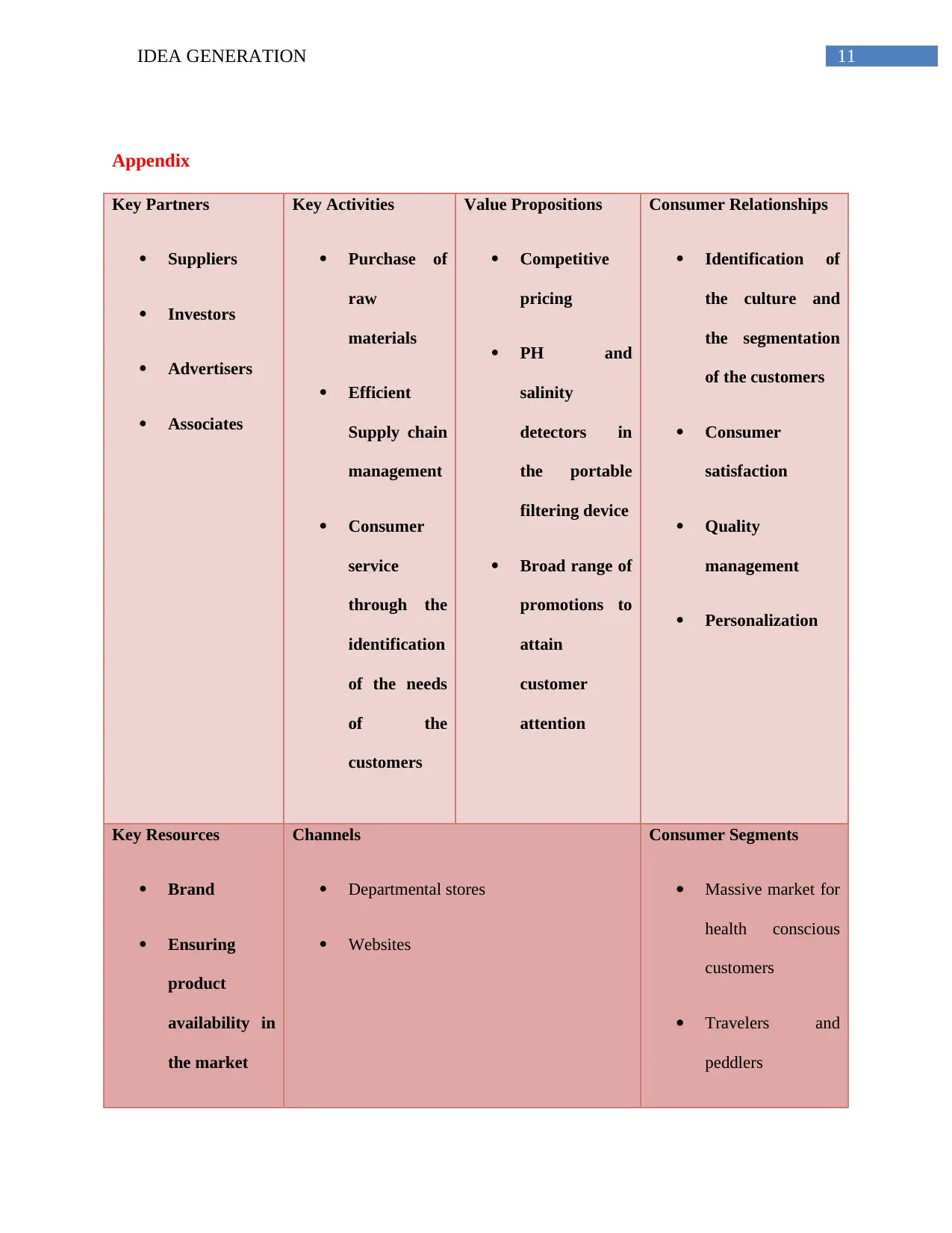
11IDEA GENERATION
Appendix
Key Partners
Suppliers
Investors
Advertisers
Associates
Key Activities
Purchase of
raw
materials
Efficient
Supply chain
management
Consumer
service
through the
identification
of the needs
of the
customers
Value Propositions
Competitive
pricing
PH and
salinity
detectors in
the portable
filtering device
Broad range of
promotions to
attain
customer
attention
Consumer Relationships
Identification of
the culture and
the segmentation
of the customers
Consumer
satisfaction
Quality
management
Personalization
Key Resources
Brand
Ensuring
product
availability in
the market
Channels
Departmental stores
Websites
Consumer Segments
Massive market for
health conscious
customers
Travelers and
peddlers
Appendix
Key Partners
Suppliers
Investors
Advertisers
Associates
Key Activities
Purchase of
raw
materials
Efficient
Supply chain
management
Consumer
service
through the
identification
of the needs
of the
customers
Value Propositions
Competitive
pricing
PH and
salinity
detectors in
the portable
filtering device
Broad range of
promotions to
attain
customer
attention
Consumer Relationships
Identification of
the culture and
the segmentation
of the customers
Consumer
satisfaction
Quality
management
Personalization
Key Resources
Brand
Ensuring
product
availability in
the market
Channels
Departmental stores
Websites
Consumer Segments
Massive market for
health conscious
customers
Travelers and
peddlers
⊘ This is a preview!⊘
Do you want full access?
Subscribe today to unlock all pages.

Trusted by 1+ million students worldwide
1 out of 13
Related Documents
Your All-in-One AI-Powered Toolkit for Academic Success.
+13062052269
info@desklib.com
Available 24*7 on WhatsApp / Email
![[object Object]](/_next/static/media/star-bottom.7253800d.svg)
Unlock your academic potential
Copyright © 2020–2025 A2Z Services. All Rights Reserved. Developed and managed by ZUCOL.





